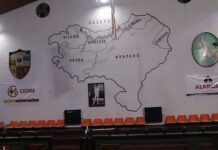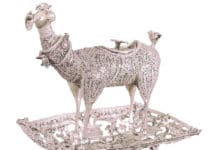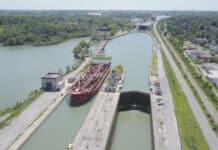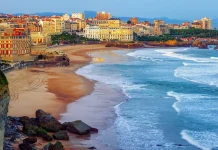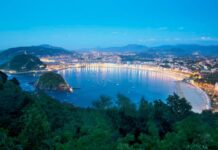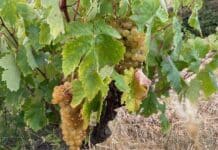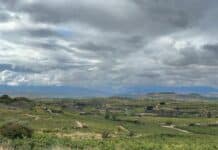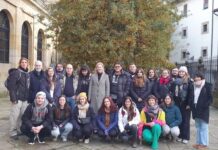Cascante
“Terror must be sown…a feeling of domination must be left, eliminating all those who don’t think like us without scruples or hesitation”
(General Mola, July 19, 1936)


Since 1901, Cascante had been one of those Towns where the Agricultural Reform had been especially important, with the repartition of Mounts Cierzo and Argenzon. The boundary markers were hard to place, and the lawsuits against the possessors were continuous. When the Republic arrived, the repartition of the communal land and the use of the corralizas became the main claims of the most disadvantaged against the great landowning dukes, barons, and families.
New schools, road repairs, and the division of the common land were the leading mottos of the popular marches in 1936, and among them, the first cries of ¡Viva el fascio!, the arrest of armed young Carlists came after a rally in Estella, or the sermons of the parish priest, designed to inflame civil and armed conflict. This gives us an idea of the social tensions in Cascante on the eve of the Military Coup.
In this tense environment, two weeks after a farmers’ strike, came the military coup. At 9:00 on the evening of Sunday, July 19, a group of armed people surrounded the La Sierra bar, where the leftists were meeting. Antonio Guardia noticed that they were going to shoot and tried to defend himself with a knife, and managed to injure Martín Jiménez, the leader of the requetés, according to written accounts.
At that precise moment, the weapons of the military coup rang out in Cascante, and they would not stop. First to fall was Salustiano Eguizabal, and alongside him Antonio Guardia. Martín Guardia, Antonio’s brother, was injured and would later die. Antonia Pérez, mother of Antonio and Martin Guardia, came to the plaza to find her sun Antonio lying dead on the ground, and Martín on the way to the hospital, and they made her run through the plaza, arms open, shouting “¡Viva España!”.
That night, many in Cascante hid or fled to the Sierra del Moncayo. Sergio Jiménez, a 25-year-old worker, married with a three-month-old daughter, and city councilman, returned believing he would not be harmed. He was arrested and on July 25, he was shot on the Milagro Bridge, and his body thrown into the river. His brother, Florencio, was forced to sign up to the National Front forces, and would die on June 17, 1938.
The arrests spread through the town. Those who stayed were forced to present themselves and were asked about who had fled, who had guns, and who was in favor of the Military Coup. Many of those who showed up were arrested. At the old school, 34 were arrested. One day 17 townsfolk were taken to Tudela, including Luis Cenarro, former judge and councilman. His familial relationship with Pérez Salas, commander of the Tudela Garrison, will save most people in Cascante, though later Emilio Fernández would be shot and Jesús “Cabrerillo” Hernández would be forced to join the National Front forces, dying on December 8, 1937.
A few days later, a new squad would reach Cascante to arrest more people, but this time the wives and children of those arrested would turn out en masse to prevent them from being taken. On August 1, five townsmen were taken to Murillo Las Limas to be shot, including the Republican mayor José Romano. Parish Priest Pablo Eneriz asked how many were being brought to be shot that day, and when told five, replied, “Too few, that’s too few.” In addition to José Romano, Ignacio “Nigiro” Lizarbe, Isidoro Tabuenca, Honorio Zamora, and Estanislao Martínez were also shot.
Demetria Aguado, the mayor’s wife, tried to take refuge with her children in Murchante, but she was turned away, and had to walk back to Cascante in the middle of summer. Her son Luis would be forced to combat with the National Front, dying on the front in September 1937.
Mari Carmen Tabuenca, Josefina Tabuenca, María Planillo, Isabel “La Cachona”, Esperanza Martínez, Pilar “The Doctor”, Antonia Jiménez, Pilar “La Urtubia”, Josefina Jiménez, Práxedes Gomara, Ángela “La Pintamoras”, Carmen “La Sequilla”, Romero “La Minuta”, María “La Tudelana”, Josefa “Manpurriela”, Dolores “Temerá”, and Rosario “La Boira” had their hair cut. Some of these women were shaved in the cow pasture and then forced to climb the hill following the bull running route with all type of insults being hurled at them. Think of your mothers, sisters, and daughters and the type of mental disease that can reach such a degree of cruelty with neighbors, and then analyze how that disease survived 40 years in charge of Spain, and don’t forget those who, in bars and taverns, half in jest and half seriously, say that “Things were better under Franco”, and remind them of the facts and the tortures of all types that the most defenseless, the wives and daughters of leftists and republicans of our Ribera region, were subjected to.
Terror was the name of the situation Cascante lived through, and the violence against the leftist and republican families of Cascante was constant and continuous. Some were forced to arrest colleagues, and other used as slaves in the fields of those on the right and those who supported the Military Coup. Without even being fed, they were taken to gather the harvest, being forced to dig irrigation canals and rivers. Women were constantly on watch for the mattress that was taken out of the prison when one was killed.
Others were killed in nearby towns. Antonio “El Pisco” Martínez and Manuel Royo were shot in Fustiñana. Galo Arbio was found in a drainage ditch in Ablitas. It is known that nine from Tarazona were shot in Urzante, a town that’s half in Cascante and half in Murchante, and that the small group that killed them was from Cascante, ordered by an outsider. The murderers helped themselves to the dead people’s things, and one wore the jacket of one of the victims for quite a long time after. By the end of the war, Tomás “Meco” Álava, José “Turara” Jiménez, Faustino Jiménez, Carmelo “Caraiputa” Jiménez (tied to the back of a van and dragged to death), Feliz “Cuchuchi” Jiménez, (water carrier and father of seven), Marino “El Barbo” Pérez, and Pablo García were also killed.
According to testimony in the book “Navarra, de la Esperanza al Terror, 1936”, the death of José Roman, leftist republican mayor, was witnessed by a priest, José Cenzano, who used to give mass at St. Mary’s in Tafalla, and who took José’s final confession before José was killed in Murillo Las Limas. According to the priest, he was shot 14 times but nobody aimed to kill. They shot him in a leg and killed another person, then in the arm and killed another person, and when blood was flowing out of him, the priest said he bled like Jesus Christ. Right at that moment, José Romano asked his killers to turn him so he could see the face of Our Lady of Romero de Cascante.
Nine years ago, on April 22, 2011, in the abandoned town of Urzante, halfway between Murchante and Cascante, the exhumations of those who had been shot in that town began. According to the inventory of the Aranzadi Study Society, in the Urzante cemetery, there were 17 dead republicans, all of them with holes in their skulls, after being finished off, and they seem to belong to those who went missing from Ablitas, Ribaforada, and the Aragonese towns of Tarazona, El Buste, Vera de Moncayo, Novallas, Vierlas, and Los Fayos.
After Franco’s death in 1975, many area families started looking for the bodies of their relatives, and many recognized them by their clothes. Thus, it would seem that there are still missing residents from Cortes, one from Valtierra, another from Ablistas, another from Ribaforada, and another from Tudela, Lucas Gallego, who was apparently shot by “El Andarín”, one of the Tudela hitmen, most likely in Bardena. The largest Ribera mass graves were, in addition to Bardena, the cemetery of Fustiñana, the mass grave of Corraliza de Fustiñana, the mass grave of Urzante, the cemetery of Tudela, the Valcaldera corral in Cadreita, and the cemetery of Milagro.
According to Fernando Mikelarena, Full Professor at the Department of Documentation and History of Science at the University of Zaragoza, in an article in Historia Nova, a contemporary history magazine, titled “La intensidad de la política franquista en 1936 en la Ribera Navarra” (The Intensity of Francoist Politics in 1936 in the Ribera of Navarre), this intensity was greater than that registered in Asturias, Granada, and Toledo; indeed, it is greater than in most provinces. Southern Navarre holds 59% of all the murders in Navarre. The repression by region or the murder rate per thousand inhabitants, according to Mikelarena, represents 21% in the Western Ribera, 14.38% in Central Ribera, and 9.95% in the Tudela Ribera, while the Navarrese average in 8.26%.
“Navarre fully and amply fulfilled all the conditions that have been imposed by the successive regulations for the granting of the highest and most valued Spanish military decoration, demands and conditions overcome by the conduct of their children. And for this reason, there is nothing more just than the granting of the Laureate Cross of San Fernando to Navarra, which closes the historical cycle during which its coat of arms takes definitive shape, linking through time the Navas de Tolosa and July 19. Both events in which the Navarrese, faithful to their historical constant, credited with their heroism and a clean record at the service of Spain” (General Salas Larrazabal).
One can lie or change history to tell the story of the victors, but by setting Navas de Tolosa as an example of their record at the service of Spain is a clear example of illiteracy at the service of Spain. Sancho VII the Strong was the King of Navarre, never the King of Spain, and he went to Navas de Tolosa as the sovereign of a Kingdom of Europe, just like Castile and Aragon were.
Last Updated on Jan 16, 2021 by About Basque Country




